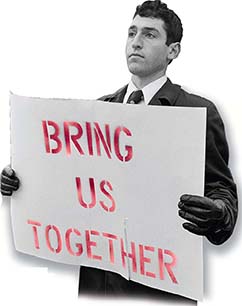SECTION 2: The Ford and Carter Years

▲ This man expresses the flagging spirit of many Americans during the late 1970s.
WITNESS HISTORY  AUDIO
AUDIO
A Crisis of Confidence
On July 4, 1976, the United States celebrated its bicentennial, or two hundredth anniversary. By the end of the decade, however, the celebratory mood had evaporated in the face of a series of crises that tested the nation’s spirit. President Jimmy Carter took note of what he called the nation’s crisis of confidence.
“The symptoms of this crisis of the American spirit are all around us. For the first time in the history of our country a majority of our people believe that the next five years will be worse than the past five years. Two thirds of the people do not even vote. The productivity of workers is actually dropping…. There is a growing disrespect for government and for churches and for schools…. This is not a message of happiness or reassurance, but it is the truth and it is a warning.”
—President Jimmy Carter, “Crisis of Confidence” speech, 1979
Objectives
- Evaluate the presidency of Gerald Ford.
- Assess the domestic policies of Jimmy Carter.
- Analyze how American society changed in the 1970s
Terms and People
- Gerald Ford
- pardon
- Jimmy Carter
- Christian fundamentalist
- amnesty
- televangelist
NoteTaking
Reading Skill: Identify Main Ideas Create an outline like the one below to record the political, economic, and social problems of the era and their impact on American society.
- Gerald Ford’s Presidency
- Major Domestic Issues
Why It Matters In 1982, historian Peter Carroll published a history of the 1970s entitled It Seemed Like Nothing Happened. Compared to the turbulent 1960s, indeed, the 1970s appeared mostly uneventful. Yet, the decade witnessed significant social, economic, and cultural changes. These changes contributed to a growing sense among Americans that something had gone wrong, that the nation had gotten off the right track. This sense of disquiet is even now a part of the nation’s political dialogue. Section Focus Question: What accounted for the changes in American attitudes during the 1970s?
Ford Faces Political and Economic Woes
Gerald Ford brought a long record of public service to the presidency. A star football player at the University of Michigan, Ford enlisted in the United States Navy and fought in World War II. Following the war, Ford successfully ran for a seat in the U.S. Congress, where he served for 25 years, rising to the position of House Minority Leader in 1965. Democrats as well as Republicans supported Ford’s nomination for Vice President because he had a stellar reputation for hard work, integrity, and dependability.
Ford stepped into a delicate situation when he became President after Richard Nixon’s resignation. Watergate had scarred the public’s faith in government. Furthermore, the nation struggled with the




